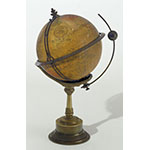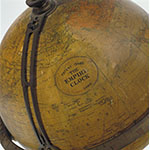A brass pedestal houses the clock and supports the rotating terrestrial globe. The hour is shown at the point where the brass semicircle meets the fixed circle placed on the equator and divided into 24 hours and their fractions. The semicircle can be shifted to any meridian, and the time difference between any location and the preselected one can be found where the other meridians intersect the hour circle. A threaded metal arc is screwed into a support under the terrestrial globe. A small globe representing the Sun can be screwed onto the arc by hand. From one solstice to the next, it moves 23.5° above or below the equator, giving the Sun's seasonal position. The terrestrial globe carries the inscription "Patent 19460 The Empire Clock Cable." The clock movement at the base of the globe is one of the countless variants of the "universal" clock, highly popular in the nineteenth century. Patent no. 19460 was issued to J. H. Overton on August 31, 1906.











